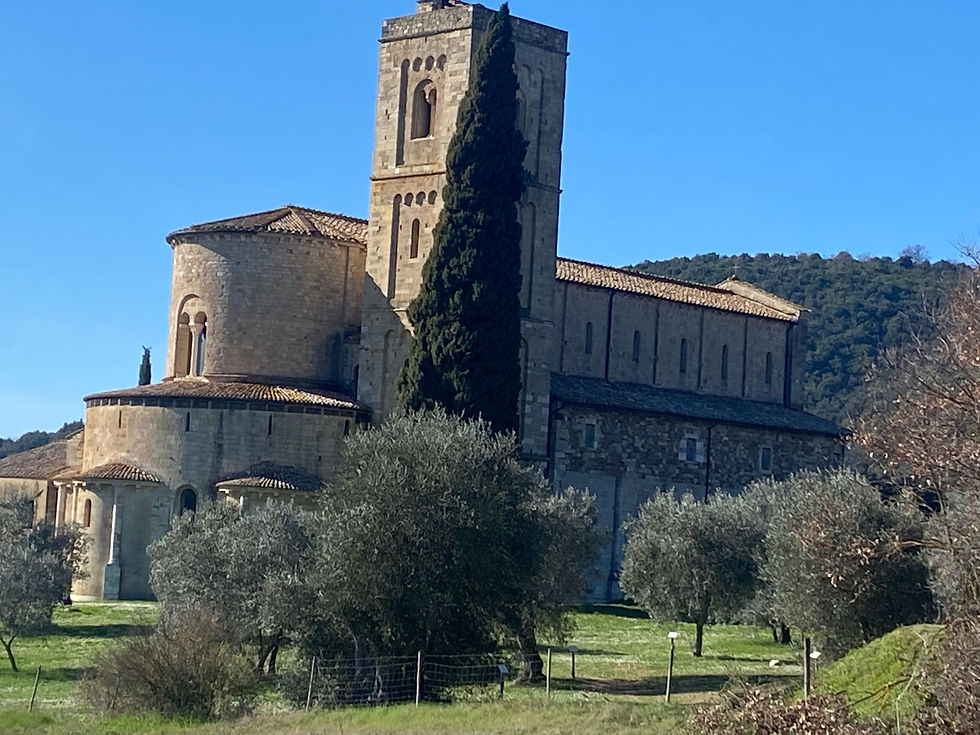PART 81: It might be interesting to share how we pulled off living in Italy for part of the year. I will post some steps we took.
We live in Puglia in the Spring and then back again in the Fall.
Step 1: As we explore towns in Italy, we discover some gems worth sharing. Some of these are well-known tourist magnets; others are lesser known but always amazing.
This week, let's explore the Abbey of Sant'Antimo in Tuscany.
Step 2: History

I have a weakness for Romanesque architecture, especially when it comes to churches. When some local friends suggested that we visit the Abbey of Sant'Antimo, claiming it is one of the most beautiful examples of Romanesque architecture in Italy, we decided to jump in our car and head towards Montalcino, which is the area in which the Abbey is found.
Italy's buildings, monuments, and sculptures are often intertwined with stories; some are historical, and others are legends. The same is true for Sant'Antimo. According to history/legend, the abbey dates from the time of Charlemagne.
The story is that Charlemagne and his court were returning from Rome along the Via Francigena and decided to camp on Monte Amiata. When the plague began spreading among the locals and his men, Charlemagne prayed and asked for help.

That night, he had a dream in which he was told to make an infusion with wine and a specific grass growing in that area; the angel in the dream said to him that the soldiers who drank this would be cured. He believed in his dream, followed the instructions, and the plague subsided. This particular grass, even today, is known as "Carolina."
The legend continues and holds that Charlemagne had a church built in the area of the Abbey in 781 in thanksgiving for his men being saved from the plague. On the right side of the church, in fact, is the 'Carolingian chapel,' perhaps the first abbey church.

1118 was the year that construction work started on the Abbey, leading to its current appearance. The Abbey is built of travertine stone, one of the most beautiful ornamental stones used in the Romanesque period. The Abbey was restored to being a place of spiritual importance only recently, thanks to the work of a community of Canons Regular, which settled here in 1992. These monks left some years later, and now a community of sisters lives at the monastery.
Step 3: Sights.
The church: When I entered the Abbey church for the first time, I noticed that there was no gold and no abundance of statues or paintings. Shafts of sunlight pierce the open spaces created by golden stone soaring towards the heavens, framing a medieval crucifix dating from the 12th century. Another wooden sculpture from around 1260 representing the 'Madonna with Holy Child Enthroned' rests against the right wall.

The interior consists of three naves, round arches resting on columns, and capitals carved with geometrical, human, animal, and flower motifs. A quiet silence circulates inside the church among walls and stone columns with a few frescoes depicting various saints.
What is unique about this Abbey church is the feeling. History and spirituality are palpable here, and attending a Sunday service brought it alive.
Garden: Saint Hildegard's Garden is not to be missed (at least during the Spring and Summer. It is closed during the Winter). Hildegard was a Benedictine abbess born in 1098 and is one of the most influential female figures of the Middle Ages. She studied how to use nature in medicine and healing; the garden named after her and the healing herbs she used are growing here. It is a beautiful, peaceful place.
Pharmacy: The Abbey pharmacy is set up in the ancient treasury room, where one can purchase food products made according to the recipes of the centuries-old monastic herbal tradition, body care products made with natural essences and medicinal herbs, Abbey beer as well as a liquor (amaro) made from Erba Carolina, a herb whose origins are intertwined with the legend of the foundation of the Abbey.
Step 4: Cool things.
The Abbey has many cultural events, from Gregorian chant to author presentations.
They have a website in Italian, which one can also navigate by using Google Translate: https://www.antimo.it
The Abbey is worth a visit. We go every time we are in the area because it is like stepping into a different world, and when we come out again, we take a bit of its peace with us.
Insights: Listening to the advice of local friends has led us to discover incredible places and experiences. The Abbey of Sant'Antimo was not on our radar until our friend said, "You must go!" We listened and were glad we did.
More next time.
In my book "She Seduced Me: A Love Affair with Rome," I bring the reader into the stories, past and present, that make the city unique. Amazon US: https://www.amazon.com/She-Seduced-Me-Love-Affair-ebook/dp/B09885RSZZ/ref=tmm_kin_swatch_0?_encoding=UTF8&qid=&sr=.
And also, on Amazon Italy,




Beautiful place. Would love to see the Abbey one day. Looks amazing and the history behind it, fascinating!